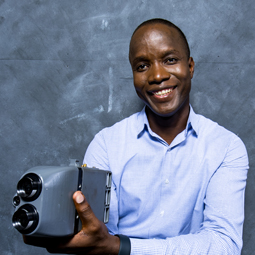Western Cape firefighter drones to use CSIR sensors
Table Mountain authorities in the Western Cape may soon call on firefighter drones to detect and extinguish small fires in hard-to-reach places before they spread to the City of Cape Town.
In March 2024, the CSIR exclusively licensed its K-Line fire sensor to a local company, Autonosky, which designed their Autono1 drone to drop fire-retardant balls on small-scale blazes.
“Autonosky specialises in extinguishing small-scale fires, but before partnering with us, they did not have the ability to detect, track and estimate the spread of small-scale fires,” says CSIR senior engineer Edwin Magidimisha. “We introduced the Autonosky team to the concept of fire dynamics and we collaborated with the company to jointly test their K-line payload for fire-detection.”

onto their firefighting drone (far right).
They will now be able to detect, track and predict the spread
of small-scale fires in real time, both onboard and on
the ground via streaming.
His team worked with Autonosky’s engineers to integrate the sensor onto the Autono1 drone using Autonosky’s specialised gimbal, and the CSIR provided the operational requirements for using the sensor to geo-locate and monitor fires in real time.
“We also showed them that not only can you stream information to the ground for post-processing, but you can actually do onboard image processing in real-time,” says Magidimisha. This means the ground station will receive processed fire-detections instead of raw data.
[This article is featured in the "Shoulder to shoulder with SMMEs" edition of ScienceScope]
He says the combination of fire-sensing and firefighting payloads now fitted onto the drone could prove invaluable during the Western Cape’s hot and windy fire season.
“In mountainous areas, one would find it very hard to drive a fire truck towards a fire, and helicopters require a lot of money and time to organise,” says Magidimisha, adding that the risk to human life is high.
“In 2018, for example, we lost a pilot fighting wildfires in the Cape.”
That same year, the K-line camera technology began detecting wildfires from space on board South Africa’s ZACUBE-2 satellite.
It is named for its ability to detect potassium (K) emitting light energy from combusting vegetation. It can pick up the tell-tale signs of a fire at a very particular point, or line, on the electromagnetic spectrum, namely the 770 nm line. This line is still within the visual light spectrum but is near where the infrared spectrum begins.
“We were the first in the world to launch such a payload,” says Magidimisha. Even back then, his team saw the potential of the K-line camera to assist with forest disaster management efforts closer to the ground.
He says that infrared sensors have traditionally been used for fire detection. “Unfortunately, these sensors register any high-radiating source as a potential fire, and they are costly,” says Magidimisha. “They require cooling for accurate detection and are prone to false detections.”
In contrast, the near-infrared K-line sensor is flaming specific, he explains. This means it has few false positive readings, and since it does not require heavy cooling equipment, it is ideal as a light payload for satellites or drones.
He adds that although no person wants a fire to break out in the windy hotspots of the Western Cape, Autonosky is already engaging with potential clients to deploy their K-line-fitted drone.
“Drones can safely and quickly access areas that may be too dangerous or inaccessible to firefighters,” he says. Putting out small-scale fires before they spread or become out of control is critical to preventing catastrophic damage to property and the loss of human life.
Magidimisha says he wants to assure other SMMEs that there are many more commercial opportunities waiting to be unlocked with the K-line technology, especially considering South Africa’s booming space industry and the fact that wildfires are becoming more frequent and disastrous due to climate change.
According to Simphiwe Mkwelo, CSIR impact area manager for optronic sensor systems, the K-line technology can be integrated into space satellite observation systems for global wildfire surveillance, fire monitoring systems for unmanned aerial vehicles (UAVs) used in tactical firefighting and ground-based systems on elevated platforms.
“The K-line UAV technology will be a game changer in the toolset of firefighters as it will reduce the cost of firefighting significantly. It also ensures access to hard-to-reach places and provides fire spread dynamics that will help with tactical decision-making,” says Mkwelo.
Autonosky
The CSIR has licensed its K-line fire detection technology to Autonosky, an SMME based in the Western Cape. Autonosky supports the Western Cape Fire Emergency Services with drone technologies that can go where human responders cannot. Their drones are optimised to extinguish small-scale fires by dropping fire-retardant balls. By adding the CSIR’s K-line camera to their payload, they will be able to detect, track and predict the spread of small-scale fires in real time, both onboard and on the ground via streaming.
With the tagline, “aerial technology solutions,” Autonosky’s CEO, Amit Ramdath, says the company leverages breakthroughs in artificial intelligence and robotics to drive innovation in aerial systems that assist rescue, fire and security organisations.
The CSIR’s K-line fire detection technology
The CSIR’s K-line technology is an optical imaging system that uses remote sensing techniques to detect potassium light energy emitted from burning vegetation during the combustion phase of fires.
Potassium, a chemical element with the periodic symbol K, is released as light energy from fires and can be easily isolated using silicon-based detectors with peak sensitivity within the near-infrared spectrum, specifically the 770 nm line. This technique has proven valuable for developing compact, affordable remote sensing systems for ground and airborne fire detection.
The K-line camera is more precise and timelier than conventional cameras in measuring fire flame location and spread dynamics due to its small pixel size, high pixel sensitivity and fast pixel response.


